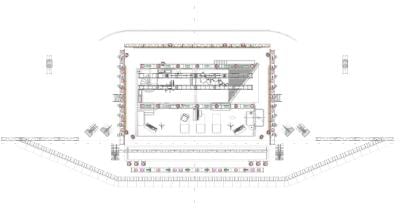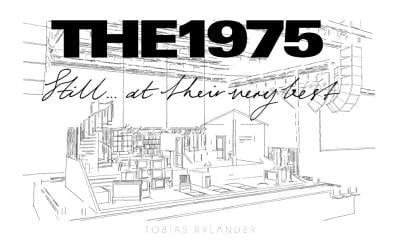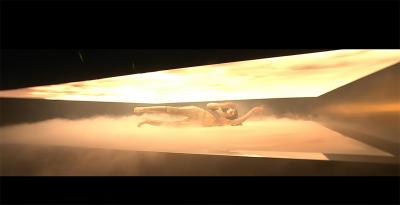Day seven of our '12 Plots Of Christmas' takes us to Sweden and into the studio and creative mind of Tobias Rylander.
In-demand lighting and production designer, Tobias Rylander, has worked with The 1975 since close to the beginning of the iconic band's career. In addition to helping to create the live persona of that band, his designs are seen all over the world with the likes of Beyoncé and The XX, in addition to the memorable "LED sandwich" set and lighting for Loreen, the 2023 Eurovision winner, bringing the competition back to his homeland of Sweden.
Rylander shared his plots with Live Design, along with his thoughts on the "LED sandwich," shopping for lighting at thrift stores, and claiming space.
Live Design: You have worked with The 1975 for a long time, do you find having the artist's trust is helpful for creativity, or do you catch yourself trying to move away from previous designs?
Tobias Rylander: Having a relationship and trust with the artist is definitely helpful. It goes both ways. With the 1975 we have always challenged each other and the industry. It always starts with a conceptual idea of Matthew Healy, the lead singer of the band. It has gone from Monochromatic black and white for the first tour to “James Turel” Art installation on stage for the second which later grew to the massive Portrait scale MFC (music for cars) tour where we focused heavily on the weight and burden of modern technological society.
With this tour and design we knew it needed to be more analogue. It needed to be about the band and their music and performance. A place and a room to invite the audience into the world of Matty and the band. It really put more pressure on the band than on me to be honest. Where before they could hide a little bit in smoke, light and silhouettes, now they were face to face with the audience and the camera right there in their living room.

LD: You have talked in the past about the detrimental influence of social media on designers. Where do you find inspiration?
TR: Absolutely! Matthew and I sort of went into depth about why and how so many shows looks the same. Not only have our shows been copied several times, but we also sort of figured out that with the social media and easily accessible information we have trends in art and design and I believe a big part of this is that we are all fed the same algorithms in Pinterest, Instagram and Google image etc. You wouldn’t believe it how often you can have an inspiration mood board from an artist or creative director and it looks exactly the same as one you got two weeks earlier by a completely different artist. We do tend to be drawn to the same things and screengrabs and downloads from Pinterest have made it very easy to be a “creative director” these days. Unfortunately, you almost get art and inspiration inflation!
I try to draw inspiration first and foremost from the artist and their current visual identity. Where are they visually within a campaign or “era” of their career. I also try to find purpose in the stage mediums. I look at theater, opera and ballet where you know each light needs purpose and function. I try to think like that when it comes to concert touring as well. Less of the walls of eye candy and quantities and be really mindful with what instruments I use and where I place them. That way light and stage become a bit more architectural and effective.

LD: Do you start with the set design and then light it, or does the lighting happen at the same time?
TR: It is usually very different where I start, but it is almost always with the concept, what do we want to show and communicate, and what do we want the audience to experience and feel. With The 1975 it started with the house. Since we knew we wanted to focus a lot on camera work and for the i-mags to look as good and cinematic as possible, I needed to design something to get background in all camera shoots. That’s how the set and the house came to be. I then needed to light it in a suitable way that not only worked well on camera, but also looked a bit timeless and elegant.
With other and previous shows, it has been so much about using the video screens and set as the main lighting source, so there it all starts with where do I need video screens to get the best silhouette or side light. Then you sneak in some lights to fill, do effects or of course do key light and front etc. That is where it is hugely beneficial to be both set, video and lighting design. You think of every detail and add or subtract where you need and find most efficient. You only have your own, the show and the clients best interest and ego to battle. The classic video vs. lighting battle doesn’t really exist.
Video Content Collaborator. Green Wall Design
LD: Green Wall Design, a frequent collaborator having worked with Rylander on Abba Voyage and Beyoncé, created all the video content for ‘Still…At Their Very Best Tour.’ Green Wall's Viktor Rundlöf describes the collaboration on this project.
Viktor Rundlöf: We produced LED content for mainly the first half of the show that focused around the latest album. We produced a library of visual assets based on a meeting we had with Tobias where we also retrieved a deck of ideas to develop. During content production we often check in to bounce ideas and feedback. On site, we explored the different assets, developed looks, elaborated on the things we liked, and scrapped the stuff that didn't work.
LD: Tobias, your designs are very structural, the "hamburger" for Loreen for example, and the living room/home for The 1975. As a lighting designer what about that appeals to you?
TR: We actually called it “ The LED Sandwich," ha ha. Those two different shows are also polar opposites. Where with Loreen we wanted a timeless, but modern design that would stand out on the Eurovision Song Contest stage. In the original design for the Swedish Preselection contest, Mellodifestivalen, the floor was also a video floor, with sand on it! I wanted to light Loreen differently and went back to using LED as the main light source. We then snuck some precise side light in between the floor and the ceiling to fill, but again the expression was really modern and installation-like.

While with The 1975 we didn’t have any LED screens at all. We went for something really analogue and traditional like a theater stage. But in both cases, you are right in that we definitely create a room within a room, claim the space whether it’s on the ESC stage or in Madison Square Garden.
LD: Do you have any go-to fixtures that you prefer to use? Why do you like them?
TR: The TMB Solaris Flare fixture family has been a staple in my show since they came out. They are such a reliable big and bright color wash with a great dimmer curve for an LED wash and of course they are a perfect strobe. The different modes and the fact that you can program them as two fixtures and in “full pixel mode” makes them a great tool to make little accents detail work with as well!
LD: Are you using any fixtures on this tour that you haven't used before? Why did you choose them?
TR: We are using tons of Astera Titan Tubes in this show. I had used them before for events and art installations but never on an arena show. I needed a linear LED fixture that could be built into the set. While LED tape and permanent installation into the set could have been an option, budget, sustainability, and maintenance didn't really allow for it.
The white fixture body made them blend with the monochromatic white house set. The brightness was really good and we knew they worked well on camera as they are used globally by gaffers in the film industry. We ran them in full color and full pixel mode which meant we could really use them as effect lighting as well as key and foot lights. They were all run wirelessly, so the crew just made sure to charge the battery between the shows and place them as soon as the set was built each day. I think it was a really great solution!
LD: Are you using off -the-shelf lamps for your practicals on stage? How did you adapt/rewire them for the tour?
TR: We have gone through a bunch of them by now, and if you by “Off the Shelf” mean the shelf at the local flea-market then yes, haha! I know the crew has had to rewire and change the sockets on a lot of them, but the color changing LED bulb in all the house fixtures are the Astera NYX Bulb, also wireless DMX but I believe we run all these on power.
LD: Has the design changed much in the US versus Europe?
TR: It has had an upgrade since it first premiered, when it hit the road the first time under the name The 1975 “ At Their Very Best” tour in November 2022, it was just the house as the main stage set and a bit smaller lighting rig. We have since then for the 2023 “Still … At Their Very Best” Tour added a big upstage curved LED Screen for set extension environments, some image looks and effect content. While doing so we also “beefed” up the lighting rig for some brighter profiles and spots, we have also added a Neon Sign and of course the addition of the FOH “B” stage, a scenic platform with a built-in ribbon lift from AllAccess housing a life size “Madame Tussaud’s “ quality replica of the lead singer Matthew Healy. It’s really incredible to see it in person next to Matty. It really creeped us out at the beginning to have a sleeping Matty behind us at FOH while programming!
LD: What is your favorite part about the lighting for this show?
TR: I think we have done a really good job at keeping the lighting very purposeful, theatrical, dramatic and cinematic. The show has got two “acts”, the first half where we focus on the band and the set where they perform more of their newer material, where we are keeping the lighting more real life and theater like, and the second act where we transform into a more show show with colors, strobes shadowplay and contrast. It’s really the best of two worlds, without any unnecessary eye candy.
LD: What were the main challenges about the lighting for this show?
TR: I hate to say it but the budget. We really needed to be super efficient to make up for the canceled tours during the pandemic. This was the first time the band went out after canceling 3/4 of the last tours and campaigns. We also had set our minds at being as environmentally cautious and efficient as we possibly could. While these were the biggest challenges, they also pushed us to really think about what we actually needed and how we could be really efficient and diverse with as little lighting as possible. Both keeping costs down and the number of trucks we used and the power we consumed. It’s difficult and challenging but it can be done!